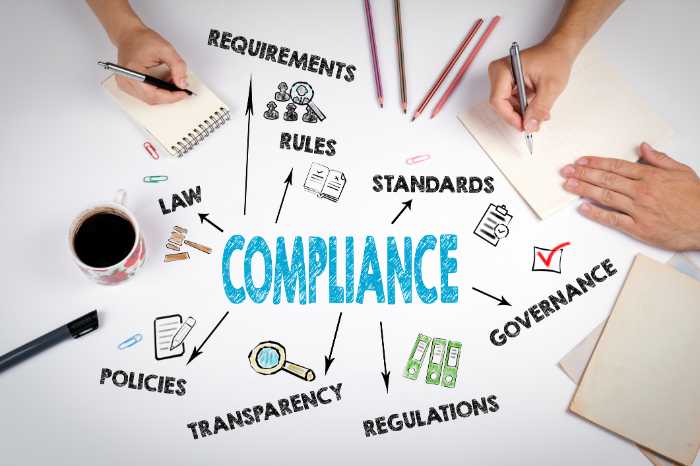
Quality control is a vital part of the construction process, but it can be challenging to know where to start.
This guide will provide you with all the information you need to get started in quality control for construction. We’ll define quality control, explain how to generate value using QC systems in construction, and talk about QC processes. We’ll also discuss key indicators and trend analysis in construction so that you can keep your projects on track.
Defining Construction Quality Control Within Your Organization
Quality control is the process of ensuring that a construction project is meeting the required standards. QC professionals complete the process by checking that the materials and quality meet the specified requirements and take corrective action when they do not.
Quality control is essential to any construction project, as it helps ensure that the finished product meets the client’s expectations, municipal and regional safety, and other precautions.
It would be best if you considered several different factors when defining construction quality control for a project:
– The specific requirements for the project, including the standards to which the work will be held accountable
– The materials and methods that the construction will use
– The workforce and their qualifications
– The tools and equipment used by construction crews
– The quality management system in place
In order to ensure your firm considers all these factors, it is essential to have a clear QC plan. This plan should outline how quality will be monitored and controlled throughout the project and include specific procedures and protocols. It is also essential to appoint a qualified QC manager responsible for implementing and overseeing the plan, but we’ll get into that later.
Generating Value For Your Business Through Quality Control Management

According to Oxford Economics, the Global Construction Industry is the tool for economic recovery from Covid. With a projected growth of US$4.5 trillion between 2020 and 2030, the need for reliable and quality construction will be greater than ever.
Aside from a growing need, QC systems create value in construction by reducing waste and improving efficiency. By identifying and correcting problems early on, QC systems can help avoid costly delays and mistakes later in the project. In addition, well-run QC systems can improve worker morale and help to build a positive team spirit.
QC managers must be aware of key indicators and trends to assess their work’s quality properly. Some key indicators include:
– Percentage of defective work vs. total work completed
– Number and type of defects found
– Percentage of re-work required
– Time needed for corrective action
By tracking these indicators, QC managers can identify trends and problems early on and take corrective action before they become too costly or challenging to fix. We’ll look more at the key indicators next.
Construction Quality Control Key Indicators and Trend Analysis

There are many key indicators in construction quality control. One of the most essential is the number of defects found and corrected before the final inspection. This indicator measures the quality of the construction and the effectiveness of the QC process.
Another key indicator is the trend analysis of the standard Defects Per Million Opportunities (DPMO). This measures how many defects exist in a given project or product. You can use it to measure the quality of a contractor’s work or to compare different contractors. Other key indicators for construction projects often include:
– number of customer complaints (review of customer satisfaction surveys)
– number of re-works and defect repairs, their time, and or/their cost (holdbacks can affect bottom line and ROI, as you know)
– number of material-related delays and their cost in time or money
– number of workmanship delays and their associated costs
– number of safety incidents and cost of incidents
– number of schedule delays
– inspections passed versus inspections failed
You can use these indicators to measure the quality of a construction project. You can also use them to compare different contractors or projects. Quality control managers should use these indicators to track their projects’ quality and make improvements where necessary.
Managing Quality Control Processes in Construction – Benefits

Since the pandemic’s beginning, the construction industry has shaken to its foundations, no pun intended. The need for beneficial processes is more significant than ever.
According to the US Census Bureau and Department of Housing, new residential construction has witnessed a steady increase in permits and construction jobs started since mid-2019. However, the amount of construction jobs completed has remained somewhat constant.
These facts reveal that construction projects have multiplied due to many factors, yet the completion rate remains constant, meaning bottlenecks are occurring, stopping a balanced flow. It powers a metaphorical vacuum within the industry, which means the need for quality construction firms is rising as projects drag on, bogging down existing construction firms entrenched in incomplete construction projects.
Quality means having a robust quality control process to ensure job specifications are exceeded and the jobs keep coming without fear of being bogged down with avoidable delays.
We can derive more critical benefits from using QC processes in construction.
- QC can help to reduce construction costs by helping to prevent errors and re-work.
- It can help improve the construction site’s safety by identifying potential hazards and implementing safety measures to mitigate them.
- Construction quality control can help improve the final product’s quality by ensuring that crews complete all work according to plan.
- It can help improve team members’ communication by providing a common standard against which all work measures.
- QC can help to improve customer satisfaction by ensuring that the final product meets or exceeds their expectations. In effect, this improves your organization’s reputation for quality construction workmanship. Quality can drive your value proposition and allow you to bid on higher-paying, higher-quality jobs with greater confidence.
Your team should perform QC tasks at regular intervals throughout the course of the project. The most common approach is to perform QC activities at key project stages, such as during design, procurement, construction, and commissioning. You can use various tools and techniques during QC activities, including visual inspections, dimensional measurements, testing and analysis, and surveys.
Tool Tip
QC managers in construction use the 1st Reporting app for Reporting Procedures and Quality Control Reporting & Analysis. It’s a comprehensive app with everything you need for all reporting needs within the construction and other industries. We’ll talk more about that later because we need to look at developing a good quality control plan first.
The first step in establishing a quality control system in a construction project is to develop a QC plan. The QC plan should specify who will be responsible for performing QC tasks, how often your team will perform those tasks, and what standards are used to measure compliance. Establishing procedures for reporting any problems or defects discovered during QC activities is essential to improving the QC process, and you should not ignore it.
The Construction Project Quality Control Plan

When creating a Construction Project Quality Control Plan, it is essential to consider the entire construction project, from beginning to end. The first step is to identify the specific goals of the quality control plan. What is the project trying to achieve? What are the client’s requirements? What are the Contractor’s requirements?
After you identify the goals of the quality control plan, the next step is to develop a strategy for how your team will accomplish these goals. This strategy should include specific tasks that must be completed for quality control to be successfully implemented.
The final step is to put the plan into action. It requires assigning specific responsibilities to team members and setting timelines for completing tasks. Regular communication and coordination between team members are essential for a successful quality control plan.
How 1st Reporting Makes Construction Quality Control Management Easier

The 1st Reporting app is an excellent tool for quality control managers in the construction industry. It helps them to complete reporting procedures and quality control reporting and analysis.
The app makes it easy to track key indicators and trend analysis. It also helps managers identify improvement areas and change their QC processes. The 1st Reporting app is a valuable tool for any quality control manager in the construction industry.
Managing quality control processes is much easier when you have a robust yet mobile solution like 1st Reporting. When you have great tools that make managing easier, it improves your job quality as well as the overall job quality due to affording you extra time to ensure perfection.
Mastering QC Management For Higher ROI

With 23% of construction companies actively taking steps to improve their organization’s job site performance, you can’t afford to wait to improve yours.
Digital reporting platforms for quality control documentation can help construction managers increase their project’s return on investment (ROI) by improving the performance of inspection and reporting-based procedures.
By completing regular QC reports and trend analyses, construction managers can catch potential issues early and prevent them from becoming more significant problems down the line. It is a crucial benefit of using a platform like 1st Reporting to track your construction project reporting for a higher overall project ROI.
A preventive methodology improves project scheduling and budgetary goals while ensuring that the finished product meets or exceeds expectations. Additionally, a digital reporting platform can automate much of the reporting process, saving time and energy your team would otherwise spend compiling data manually.
Use a Unified Reporting System

A unified reporting system for quality control and safety management has many benefits.
A single platform for all reporting needs makes tracking and analyzing data more accessible. It helps managers identify improvement areas and make changes to their processes.
Having all data collected in one place makes it easier to identify trends and patterns.
A unified reporting system helps keep projects on schedule and budget while ensuring that the finished product meets or exceeds expectations.
We would be foolish not to mention how a unified platform extends more accessible communications across an entire organization.
Did we note that 1st Reporting also works across multiple devices? So, it isn’t just a unified solution; it’s an extensively compatible one.
Overall, using a unified reporting system for quality control and safety management provides many benefits and is the best way to ensure that your project is successful.
Include Automated Communications and Dynamic Workflows

Form building and reporting applications are a great way to collect data and generate reports. Still, they can be even more powerful when combined with automated notifications and custom dynamic workflows.
Using these features, you can create a system that automatically notifies you of any changes or problems as they occur, so you can take action quickly and prevent any further issues. You can also customize your workflows to match the specific needs of your business, ensuring that all the data is collected and reported exactly the way you need it.
1st Reporting takes customized form building to the next level with our customization potential using dynamic forms. Add other powerful features like report linking, and you’ve got one of Earth’s most powerful and versatile reporting platforms.
Integrate With Existing Platforms

Regarding construction quality control, having a form building and reporting application that can integrate with platforms like Microsoft Teams® is vital. By integrating with existing platforms, managers can save time and ensure that all team members keep up to date on project progress.
Additionally, using an app that offers customizable forms and report templates can help generate valuable data that you can use for trend analysis.
The 1st Reporting app works seamlessly within the Teams® environment to receive notifications and share information. By integrating with Teams®, you don’t have to maintain multiple applications operating simultaneously. You can get the notifications right in your Teams® dashboard, so you can take action at the moment when you need to.
Summary
Construction quality control is essential to ensuring that projects are on time, within budget, and to the specified standards. There are many aspects to construction quality control, from defining quality standards to creating a QC plan.
Additionally, quality control managers must be able to collect data and generate reports. The best way to do this is by using a form building and reporting app like 1st Reporting.
1st Reporting offers many essential features for construction quality control, including automated communications, dynamic workflows, and integrations with existing platforms. Using 1st Reporting, you can improve the time saved and ensure that your project has a more significant potential for success.